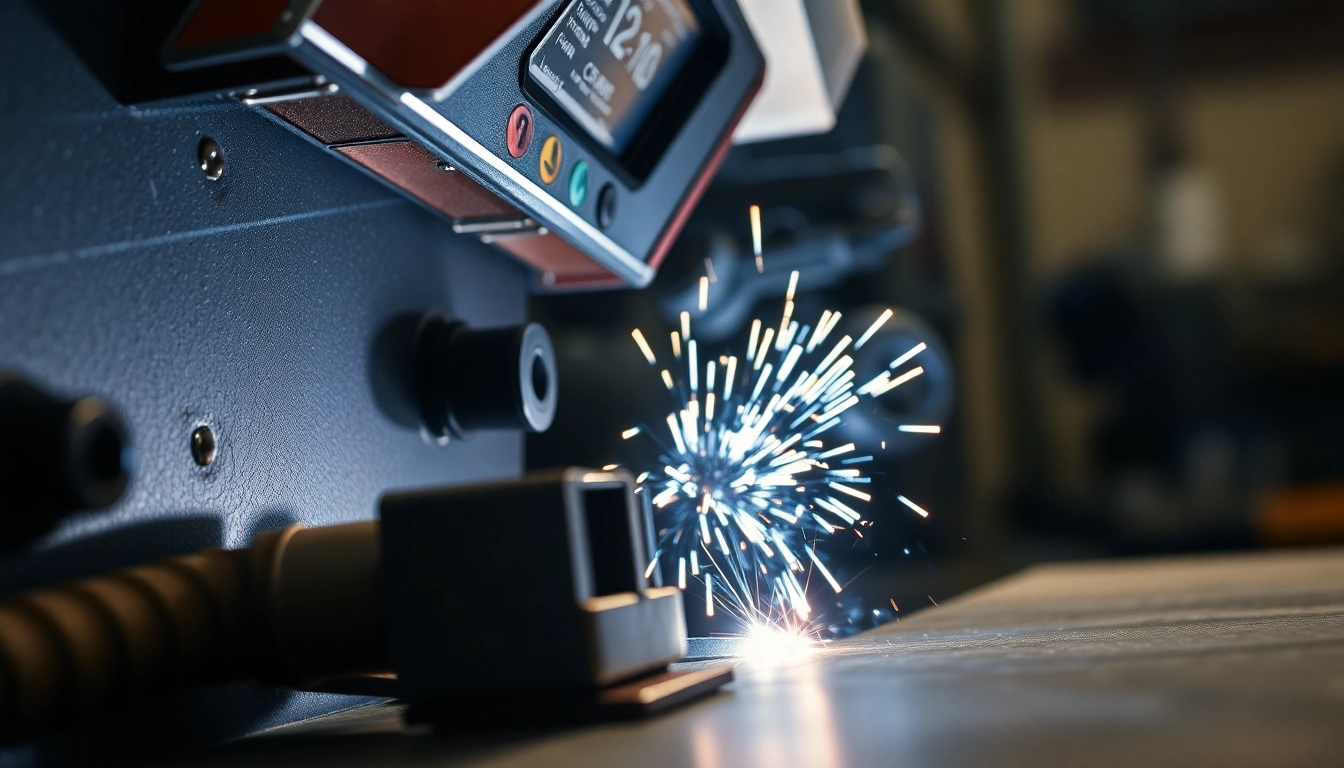Understanding AC DC TIG Welders
What is an AC DC TIG Welder?
An ac dc tig welder is a versatile welding machine utilized for Tungsten Inert Gas (TIG) welding. This type of welder is capable of producing welds using both alternating current (AC) and direct current (DC), allowing it to work with a wider array of materials, including aluminum, stainless steel, and mild steel. The ability to switch between AC and DC makes these machines incredibly valuable for projects that require versatility in welding applications.
How AC DC TIG Welders Work
AC DC TIG welders operate by creating a controlled arc between a non-consumable tungsten electrode and the workpiece being welded. When AC is used, the current reverses direction, allowing for improved cleaning action on metals like aluminum, which often have an oxidized surface. DC, on the other hand, is preferred for welding ferrous metals, where a stable and continuous arc is needed.
The switching between AC and DC can be controlled through the machine’s settings, allowing welders to adjust their techniques based on the materials and thicknesses involved. In addition, most modern AC DC TIG welders feature advanced digital controls and displays, making it easier to achieve precise settings without the trial-and-error method typically associated with analog machines.
Benefits of Using AC DC TIG Welders
Using an AC DC TIG welder comes with a comprehensive range of benefits:
- Versatility: The ability to switch between AC and DC allows welders to work with a variety of materials, optimizing their techniques for different applications.
- Precision: TIG welding is renowned for its accuracy, making it ideal for intricate work and thin materials where precision is critical.
- Clean Welding: The TIG process produces cleaner welds with less slag, resulting in a superior finish compared to other welding methods like MIG.
- Less Post-Weld Cleaning: Due to the precise nature of TIG welding, there is often less cleanup required after the welding process.
- Energy Efficiency: AC DC TIG welders typically offer higher energy efficiency compared to traditional welding machines, translating to reduced operational costs.
Key Features of Top AC DC TIG Welders
Power Output and Versatility
The power output of an AC DC TIG welder is crucial for determining what types of materials and thicknesses can be welded effectively. Most capable machines offer a range of output, usually between 200 to 300 amps, which allows them to tackle moderate to heavy welding tasks. When choosing a welder, consider the highest thickness of material you plan to work with, as this will influence your purchase decision.
Versatility in welding capabilities also includes factors such as the type of welding (TIG vs. stick), ability to weld different metals, and compatibility with various filler materials. Modern machines may include multiple modes depending on project requirements, enabling users to switch with ease.
Control Options: Analog vs. Digital
AC DC TIG welders come equipped with either analog or digital control systems, each offering distinct advantages. Analog controls tend to provide a hands-on approach, which some welders find intuitive. However, digital controls are becoming increasingly popular because they enable precise adjustments, often allowing for programmable setups and saving previous settings. Digital interfaces might also provide additional information through displays, such as real-time amperage readings, which can greatly assist in maintaining the desired output throughout the welding process.
Recommended Accessories for Efficiency
To maximize the usability and efficiency of an AC DC TIG welder, consider investing in essential accessories, including:
- Tungsten Electrodes: Various grades and sizes of tungsten electrodes can influence the quality of the weld, particularly when working with varying materials.
- Filler Rods: A selection of filler rods compatible with the metals being welded ensures stronger bonds and reliability.
- Argon Tanks: Argon shielding gas is essential for TIG welding, preventing contamination and enhancing the quality of the weld.
- Foot Pedal Control: For enhanced control over amperage during welding, a foot pedal can provide the ability to adjust power without needing to move hands from the workpiece.
- Protective Gear: Essential equipment like helmets, gloves, and aprons are vital for safeguarding against hot sparks and UV exposure.
Choosing the Right AC DC TIG Welder for Your Needs
Factors to Consider Before Purchase
When selecting an AC DC TIG welder, several factors should be taken into consideration to find the model that best fits your needs:
- Type of Material: Determine the primary materials you will be welding to ensure the welder can handle the required thickness and specifications.
- Power Requirements: Assess your power availability in the workshop to ensure the welder you choose will operate efficiently with the existing setup.
- Cost and Budget: While it can be tempting to cut costs, investing in a higher quality welder often pays off in terms of performance and durability.
- Warranty and Support: A good warranty can indicate manufacturer confidence while providing peace of mind in the event of defects or damages.
- User Reviews: Look for experiences shared by other welders about the performance and issues encountered with specific models.
Top Brands to Look For
Several brands have established themselves as leaders in manufacturing AC DC TIG welders. These brands are known for their reliability, innovative features, and customer satisfaction:
- Miller Electric: Recognized for their high-quality machines, Miller welders provide excellent performance and a range of options for professional welders.
- Lincoln Electric: Known for their durability, Lincoln welders are great for both hobbyists and professionals alike, offering options for various materials.
- Everlast: A more budget-friendly choice that still provides strong performance, making it popular for new users and small businesses.
- Hobart: Offers a range of solid welders recognized for their ease of use and versatile capabilities, an excellent choice for home use.
Common User Mistakes and How to Avoid Them
Even experienced welders can make mistakes with AC DC TIG welders. Here are some commonly encountered pitfalls and strategies to avoid them:
- Incorrect Settings: Always double-check the settings depending on the thickness and type of material being used. Adjust the amperage and polarity accordingly.
- Lack of Preparation: Clean the metal surfaces thoroughly before welding. Improper cleaning can lead to contamination and poor-quality welds.
- Poor Electrode Management: Selecting the wrong tungsten type or improper grinding can negatively impact weld quality. Ensure correct preparation and choose the right tungsten for the job.
- Inconsistent Speed: Maintaining a steady hand and consistent speed is crucial. Practice on scrap material to gain confidence and ensure even penetration.
- Not Wearing Protective Gear: Never compromise safety; use appropriate gear to protect from sparks and hazardous UV exposure.
Techniques for Effective TIG Welding
Welding Aluminum with AC DC TIG Welders
Welding aluminum can be tricky due to its thermal conductivity and tendency to form oxides on the surface. Using an AC DC TIG welder allows for effective cleaning action:
- Choose AC settings for aluminum welds to break apart these oxides effectively.
- Utilize a higher frequency for better arc control.
- Select the right filler rod that matches the aluminum alloy being welded to ensure a solid bond.
Controlling Heat and Speed for Best Results
Managing heat input is crucial for preventing warping and distortions in welded materials. To control heat and speed effectively:
- Practice maintaining a consistent travel speed that matches the material thickness.
- Consider utilizing pulse welding techniques, which allows for better control of both heat and arc direction.
- Pay attention to the appearance of the weld pool; a well-shaped weld pool indicates proper heat and speed balance.
Safety Practices While Welding
Safety should always be a primary concern in welding environments. To keep yourself safe when using an AC DC TIG welder:
- Ensure proper ventilation in your workspace to avoid inhalation of fumes.
- Always wear appropriate protective gear, including a welding helmet, gloves, and flame-resistant clothing.
- Keep a fire extinguisher nearby, ready for immediate use if necessary.
- Regularly inspect your welding equipment for any damage or wear, ensuring safe operation.
Where to Buy Your AC DC TIG Welder
Online Marketplaces vs. Local Stores
When purchasing an AC DC TIG welder, consider your options between online marketplaces and local stores. Online marketplaces tend to offer a broader selection and might provide competitive pricing. However, local stores allow you to see and potentially test the machine before buying, which can be invaluable if you’re making a significant investment.
Price Comparisons: Finding the Best Deals
It is essential to do thorough price comparisons before making a decision. Pricing can vary significantly based on features and specifications. Look out for promotions, seasonal sales, and package deals that can provide greater value. Additionally, consider the long-term costs of consumables and maintenance when evaluating price.
Warranty and Post-Purchase Support
A solid warranty can ensure confidence in your purchase. Always check the warranty period and what it covers. Manufacturer support can also be a factor; ensure that the company is accessible and can help resolve any issues promptly. Check product reviews regarding customer service experiences to get an idea of the company’s reputation.



